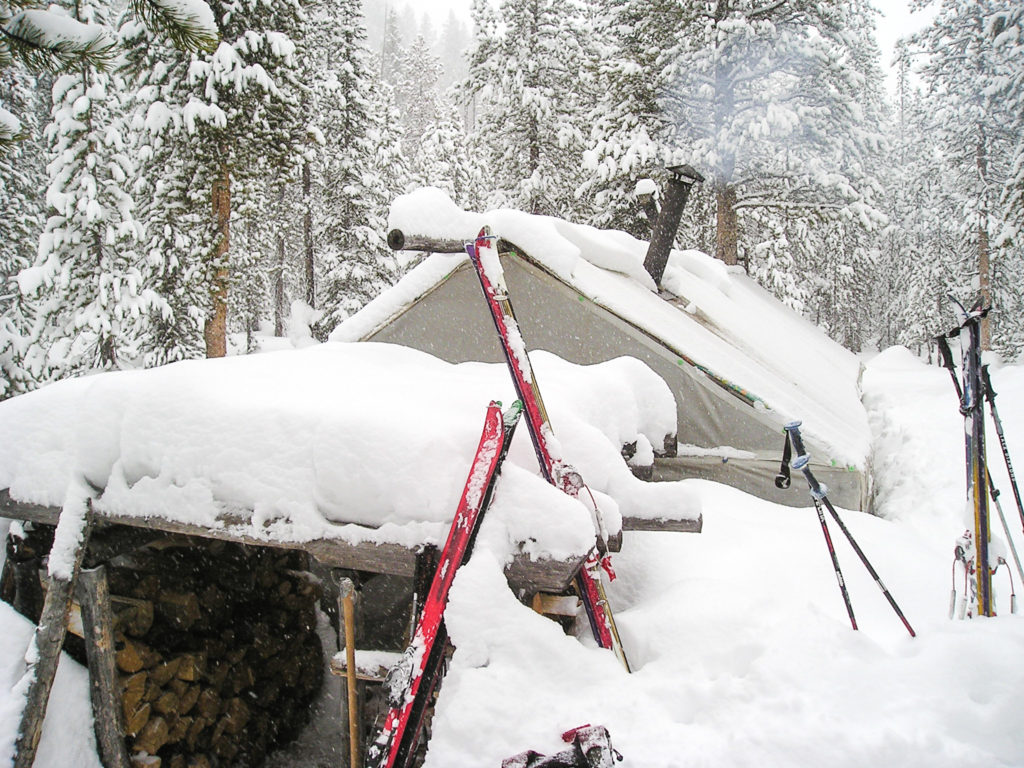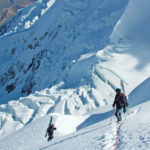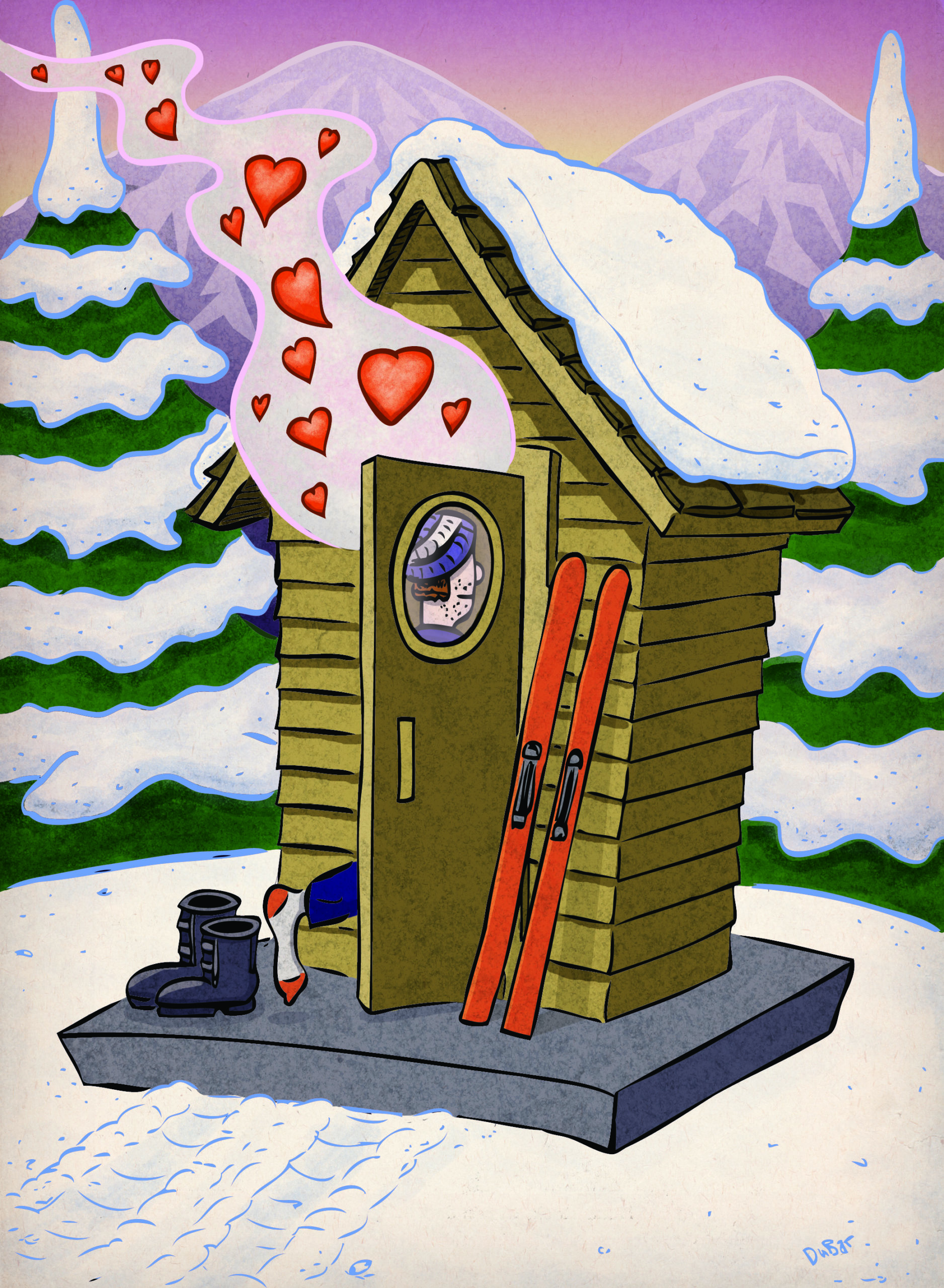I watched the flames rise higher as the roof beams became engulfed. The metal spikes embedded in the old wood glowed like lava. The heat warmed the two of us as we passed the whisky bottle and roasted our sausage. The burning hut was no accident. It was a calculated decision that I began to second guess as soon as I dropped the match onto the gasoline. There were over 20 years of memories made by friends in backcountry revelry and I could feel them release in the flames. It was the end of an era and now I was committed to follow through.
In 1982, Bob Jonas was inspired to build ski huts on the edge of the wilderness boundary. For intrepid skiers, the huts would grant access to the inner sanctum of the Sawtooth Mountains. Bob was no stranger to living in wilderness. This Idaho native had recently returned from years in Alaska where he had homesteaded at the headwaters of the Nizina River in the heart of St. Elias Range. It took months of trekking through the mountains for Bob and partner to find the rocky knoll far from the outside world. Living on moose, salmon and berries they built a cabin where his partner lives to this day. After a winter in the bush, Bob decided to return to his native mountains of central Idaho, but couldn’t shake his need for wildness. He had recently taken over an outfitting business from Joe Leonard that catered to backcountry skiers. Joe had built two yurts on the icy perimeter of the broad Sawtooth Valley to house skiers. These huts were perfectly situated for kicking and gliding along the edge of the precipitous and craggy peaks, but Bob wanted to go deeper into the mountains. Bob moved the yurts to the edge of the wilderness boundary— Fishhook Yurt was built on a majestic meadow with a wood fired hot-tub surrounded by the Sawtooth giants and Bench Yurt was built on the shoulder of Mt. Heyburn 1000’ above to access skiing amongst the jagged spires and couloirs of Heyburn and the Monolith Valley. Sun Valley Trekking was born.
Winter of 1983 was a big snow year. A March blizzard set in on the Sawtooth high country and dumped four feet of snow on the already buried Bench Yurt. The homemade yurt crumpled under the deep snow. The resulting pile of splintered debris was a catastrophic mess. Little was salvageable and it was clear that a new hut would have to be built. To build what would become the Bench Hut was not an easy proposition. Funds were low and logistics were challenging. There was no yurt to move and he couldn’t afford to buy another yurt, so Bob decided to build with the native lodgepole pine that timbered the mountain slope. The new hut was to be a timber-framed wall tent, “like the pioneers used” Bob would say. It was a low slung structure held together with spikes where a level and square were never employed. The floor was made of narrow diameter tree trunks laid horizontally and snugged together and was infamously known as the drunken sailor floor—no one could walk the length of the hut in ski boots without a stumble. Each sleeping bunk was uniquely askew and every regular had his or her preferred bunk, but rarely the same one. With all its funkiness, the Bench Hut became a favorite and slowly worked its way toward legendary status among the few that knew it.
What makes the Bench Hut so beloved is its location. At a first glance, the dog-haired forest in the swale at the edge of the wilderness boundary may not immediately inspire like some other hut sites. It takes a bit more exploration and effort to discover the magical ski terrain that surrounds it. Skiing the gentle inclines of the Crapper slope (named for its location above the outhouse-of course) gives a glimpse up toward the gothic spires of the Heyburn massif. Like flying buttresses of an ancient cathedral, bowls and couloirs split the granitic fault lines with perfect ribbons of snow. Dig a bit deeper and push through the 5 alpine lakes that dot the basin above and skiers arrive at the Silver Saddle gaining entry into the mythical Monolith Valley. Like a Karakoram in miniature, the Sawtooth are nothing short of spectacular.
By the year 2012, the Bench Hut was showing its age. As the steward of Sun Valley Trekking, I had exhausted all the spikes, duct tape and other “band aids” I could apply to this iconic hut over the previous 12 years of my tenure. It struck me that it was time to start anew. The plan involved tearing down and burning the old hut—then rebuilding from scratch, bottom up. As with Bob, funds were low and logistics were complicated to build a new hut. Added to this was the restrained controversy but high expectations that come when destroying and then remaking a beloved ski hut on public lands.
I am a ski guide, not a carpenter. My entire carpentry resume was developed by necessity while maintaining the 6 huts that comprise the SVT system. Although my woodworking techniques often raised the eyebrows of carpenters, they seemed to get the job done; but with this project, I was determined to get it right. As a mountain guide, my logistical skills were far more honed than my carpentry skills and much of the challenge of this project lay in its logistics. We did not have the funds to helicopter in building materials and to haul in by horse or human was impractical. Like Bob, we would use the plentiful local lodgepole pine. The recent bark beetle plague had made this resource abundant.
Living and guiding out of the huts for years, I had come to recognize what worked and what didn’t work in a ski hut design. The low slung and narrow shotgun shack design of the old hut had its charms and awkwardness. Unlike the old hut, we wanted windows that brought in the western light and views of the spectacular spires on Mt. Heyburn above. We sought a flat deck for a floor, level bunks and a spacious common area. We were required by our special use permit with the Forest Service to build a “temporary” structure whose footprint was no larger than the old hut, so efficient design of space and materials was critical. The entire design was laid out in pencil on a scrap of paper and we began to work.
The first phase of the project began in late April, the end of the winter operating season. We wanted snow on the ground in order to skid the logs into the site and to mill the floor boards. After years of cutting 10+ cord of firewood a season on skis, we were well accustomed to moving lots of wood over snow. I had found my dream chainsaw in a newspaper ad the month before, a virtually new Stihl 661 pro-model with a 36” bar. The price was right and the power was what we needed to run the Alaskan chainsaw mill. With a crew of 8 ski guides and apprentices, we embarked on skis into the Sawtooth early one snowy April morning. The plywood for the bunks, food for 6 days and many gallons of fuel, beer and whisky made the ski-sled loads rough, but the end of a ski season finds guides with seemingly super-human strength and endurance. Once positioned at the hut, we marveled at the spring blizzard dumping snow while we searched for the first trees to drop for the milling.
This was my first experience with an Alaskan chainsaw mill. It took some figuring to get the initial tree set up for cutting floorboards. While scratching my head and taking measurements, the crew began to gaze up at the powder piling onto the slope above our mill site. Rather than having 6 dudes standing around and waiting for a board to drop off our makeshift mill, we devised a plan that could satisfy the skier in a ski hut construction project. It was quickly agreed that the preferred method to proceed would involve 2 millers working with the saw. All other hands would climb the crapper slope above and ski powder down to the mill site, where a board would be loaded and skied into the hut. This method worked beautifully. While sucking two-stroke fumes on the mill I would gaze up as skiers came bounding through the powder. Every newly cut floor board was delivered to the hut on skis with a powder laden grin. This was good omen and felt like the right way to build a ski hut.
By late May, the floorboards had all been milled and stacked and the deconstruction and burning phase of the project began. There were mixed feelings about tearing down a historic and functional hut. We were excited about the prospect of building something better and anxious about getting it done in time for the following ski season. When fellow guide, Pato, and I arrived with crow bars and sledge hammers we found a very fat pine marten had taken up residence at the hut. The marten had discovered the 2 large Tupperware containers that we had stocked with food for the summer construction project and managed to weasel his way in and consume close to two hundred energy bars. He was at home fat, happy and did not want to leave. By sunset, we had about half the hut torn down and piled and we decided to sleep on the open bunks that remained. Throughout that restless night, we could hear the hissing of one very angry pine marten perched on a neighboring tree. By the next day, the entire Bench hut lay in a large spiky pile in the clearing and the burn began. We fed and managed the fire for the next 24 hours and once out, raked the ash and coals to remove all the old spikes and nails. We now had a blank slate.
The construction of the new hut was scheduled to take place in July. I had devised a plan for building the hut that involved setting up a base camp at the far end of Redfish Lake, 1100’ below. The building site was far from water and we wanted to have a generator to charge our battery tools. Carrying water, a generator, food and camping gear to the site seemed less desirable than camping on the shores of the deep and clear Redfish Lake and commuting each day to the hut on mountain bikes. We were able to load all our equipment onto the Redfish shuttle boat and motor it 6 miles across the glacial carved lake to set up a camp beneath the spires known as the pearly gates. This plan allowed for a good warm up each morning and a screaming downhill single-track ride to get back to camp. Each evening was capped with a sunset dip, a large meal and plentiful cold beer.
The construction of the new hut went remarkably smooth. We divided into teams: the foragers were dispersed into the forest with chainsaws and a list of materials to gather – kind of like going to the lumber yard. We had a team assigned to the floor, which proved to be painstakingly slow task of piecing together the extremely valuable boards we had milled back in April into a mosaic of level deck. No board was wasted and every board was utilized. We had the framing team that would call out what they needed to the foragers and then set to work to create the super structure. This was no small hut. In order to meet the requirements of the footprint size specified by the Forest Service and our requirements for space, aesthetic and flow, I had settled on a somewhat unique shed roof design. The front wall stood 12 feet above the deck and 14 feet from the ground, allowing for 40’ long window and spacious upper bunks along the wall. 14 feet tall did not seem like an issue when I sketched the design. But once I was standing on the ladder, on uneven ground with spinning chainsaw in my hand to make the required post-rafter cuts, it felt like a bigwall. Unfortunately this maneuver had to be repeated for each of the eleven posts and I felt lucky to finish still in one piece.
After seven days of waking in the dark on the far shores of Redfish Lake and riding bikes through morning mists to work for 12 hours we had completed the structure. It stood proud and beautiful. Each bench was custom built to provide lumbar support and take in a unique view. The floor was flat and every bunk was spacious and level. Best of all, when surveying the hut, we could appreciate that every piece of wood had come from within 100 yards. We weren’t done yet, but after a celebratory toast, we took measurements for covers and rode the final downhill back to our camp.
The next phase of the project took place in September when the custom covers came from a craftsman in Idaho Falls. Since the roof piece alone weighed close to 200lbs, we hired a couple of horses to pack in the covers. I had some anxiety about the covers for I realized I had made a mistake when measuring the structure back in July. It was one of those realizations that wake you in the middle of a deep sleep and cause you to pull yourself from bed to correct it. I wasn’t sure if my correction would work and getting the covers hung on the structure was a huge relief. Fully dressed, the new hut looked great. Sunshine through the massive window warmed the inside and the rock spires seemed even more dramatic with their new frame. I walked away from the hut with a huge sense of satisfaction. The next visit would be when the snow was flying and would be the final piece of the project.
Building a new Bench hut began with flames and ended with flames. When an early November blizzard brought a foot of snow to the Sawtooth, I put a call out to all those that helped with the construction and we convened at the new hut. Surrounding the hut site were a dozen slash piles, the woody leftovers from the milling and construction, and now it was time to burn them. With snow piling on shoulders and whisky bottles passing, fires sparkled in every direction shimmering through the falling stellars on the new hut. There was a deep felt satisfaction among all of us that labored to watch the snow accumulate on the new Bench Hut. We knew how stoked each skier would be when they arrived – for many winters to come.


















This is amazing, thank you for sharing!! I’ve begun snowboarding recently and I’m excited to start backcountry soon. I’m hoping I’ll be able to participate in a hut project sometime during my life!